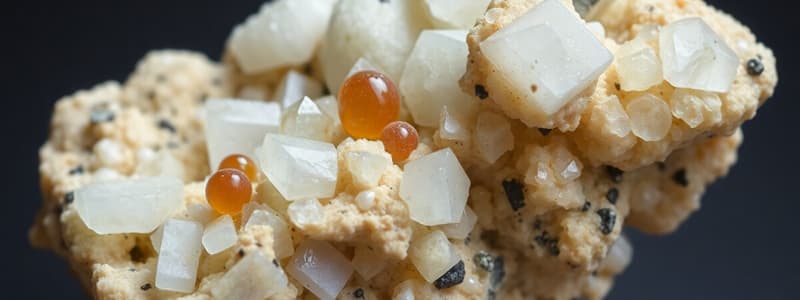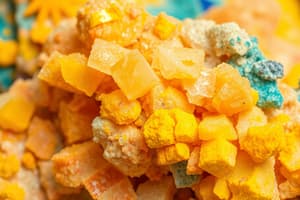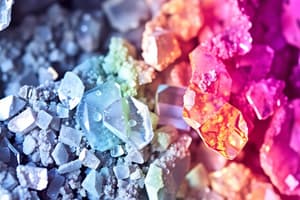Podcast
Questions and Answers
Which condition most accurately describes the formation of a mineral from magma?
Which condition most accurately describes the formation of a mineral from magma?
- Crystallization from magma involves the orderly arrangement of atoms into a repeating 3-D array as the magma cools. (correct)
- Crystallization involves the rapid cooling of magma, preventing the formation of large, well-formed crystals.
- Crystallization involves the combination of quartz, feldspar and mica in granite
- Crystallization occurs only at the Earth's surface where magma is exposed to the atmosphere.
What distinguishes a mineral's streak from its color?
What distinguishes a mineral's streak from its color?
- Streak is the color of the mineral in powdered form, which tends to be more consistent than the mineral's color. (correct)
- Streak is tested using porcelain, while color is observed by scratching with a knife
- Streak is the color of the mineral in its massive form, while color is the appearance of the powdered form.
- Streak is more variable than color and is affected by impurities within the mineral's structure.
Which statement accurately contrasts metallic and nonmetallic luster?
Which statement accurately contrasts metallic and nonmetallic luster?
- Metallic luster appears similar to polished metal, while nonmetallic luster can range from shiny to dull in appearance. (correct)
- Metallic luster is a property exclusive to native elements, unlike nonmetallic luster.
- Metallic luster describes minerals that appear dull, whereas nonmetallic luster refers to those that shine like polished metal.
- Metallic luster always indicates the presence of metal elements in the mineral's composition.
How does crystal growth in the solid state contribute to mineral formation, as exemplified by mica, garnet, and feldspar in schist?
How does crystal growth in the solid state contribute to mineral formation, as exemplified by mica, garnet, and feldspar in schist?
Which of the following minerals is most likely to exhibit double refraction?
Which of the following minerals is most likely to exhibit double refraction?
How do geologists utilize the property of magnetism to differentiate between magnetite ($Fe_3O_4$) and hematite ($Fe_2O_3$)?
How do geologists utilize the property of magnetism to differentiate between magnetite ($Fe_3O_4$) and hematite ($Fe_2O_3$)?
What distinguishes a mineral with conchoidal fracture from one with even fracture?
What distinguishes a mineral with conchoidal fracture from one with even fracture?
Why is color considered a less reliable property for mineral identification compared to streak or luster?
Why is color considered a less reliable property for mineral identification compared to streak or luster?
What criteria differentiate a mineral from a rock?
What criteria differentiate a mineral from a rock?
How does the chemical composition of silicates differ from that of carbonates?
How does the chemical composition of silicates differ from that of carbonates?
Which is an accurate statement regarding the property of diaphaneity in minerals?
Which is an accurate statement regarding the property of diaphaneity in minerals?
When classifying the hardness of minerals, how does the hardness of gypsum compare to that of calcite and fluorite?
When classifying the hardness of minerals, how does the hardness of gypsum compare to that of calcite and fluorite?
How would you accurately describe the process of mineral formation through precipitation from solution?
How would you accurately describe the process of mineral formation through precipitation from solution?
How is the concept of 'streak' applied in mineral identification, and why is it particularly useful?
How is the concept of 'streak' applied in mineral identification, and why is it particularly useful?
What role do 'striations' play in identifying plagioclase feldspar?
What role do 'striations' play in identifying plagioclase feldspar?
Flashcards
Naturally Occurring
Naturally Occurring
Found in nature, not synthetic.
Generally Inorganic
Generally Inorganic
Formed independently of plants and animals with the possibility of organic carbon secreted by organism, calcite shells.
Homogenous
Homogenous
Composed of a single element or compound; mixtures of compounds are excluded.
Definite Chemical Composition
Definite Chemical Composition
Signup and view all the flashcards
Ordered Internal Structure
Ordered Internal Structure
Signup and view all the flashcards
Mineral Formation
Mineral Formation
Signup and view all the flashcards
Mineral Formation
Mineral Formation
Signup and view all the flashcards
Mineral Formation
Mineral Formation
Signup and view all the flashcards
Silicates
Silicates
Signup and view all the flashcards
Carbonates
Carbonates
Signup and view all the flashcards
Mineral Color
Mineral Color
Signup and view all the flashcards
Streak
Streak
Signup and view all the flashcards
Luster
Luster
Signup and view all the flashcards
Hardness
Hardness
Signup and view all the flashcards
Specific Gravity
Specific Gravity
Signup and view all the flashcards
Study Notes
- To be considered a mineral it must be naturally occurring, generally inorganic, homogenous, solid, have a definite chemical composition, and have an ordered internal structure
Naturally Occurring
- Minerals are found in nature
- Minerals are not synthetic
Generally inorganic
- Minerals are formed independently of plants and animals
- Minerals may be secreted by organisms, like calcite shells
Homogenous
- Composed of a single element or compound
- Mixtures of compounds are not included
Definite Chemical Composition
- Minerals have a unique combination and a fixed ratio of atoms, or narrow range
Ordered Internal Structure
- Minerals are composed of atoms arranged in an orderly, repeating, 3-D array
- Minerals have repeated parts and uniform spacing
- Minerals can form from crystallization from magma
- This include quartz, feldspar, and mica in granite
- Minerals can experience crystal growth in the solid state
- These are commonly Mica, Garnet, and Feldspar in schist
- Minerals can be created from precipitation from solution
- For example, calcite in marine organisms shells, and silica in agate
Classification of Minerals
- Silicates are composed of Si+ & O2-, combined with cations
- Carbonates are composed of Ca2+, Mg2+, & (CO3)2-
- Oxides are composed of O2- & metallic cations
- Sulfides are composed of S2- & metallic cations
- Sulfates are composed of (SO4)2- & metallic cations
- Halides are composed of Cl-, F-, Br-, I- & cations
- Hydroxides are composed of (OH)- & cations
- Examples of Native Elements include Cu and Au
Physical Properties of Minerals
- The color is not constant in most of the minerals
- The color is commonly due to stain or impurities in the minerals
Streak
- This is the color of the mineral powder, it is more nearly constant than the color
- The streak is determined by marking unglazed porcelain or simply by scratching it with a knife and observing the color of the powder
Luster
- This is the appearance of a fresh surface of a mineral in ordinary reflected light
- Metallic luster looks like polished metal
- Nonmetallic luster does not look like metallic and can be shiny or dull
Hardness
- This is the resistance of mineral offers to abrasion or scratching
- It's measured relative to a standard scale of ten minerals known as the Moh's scale of hardness
- Talc is 1, Gypsum is 2, Calcite is 3, Flourite is 4, and Apatite is 5
- Gypsum is soft; it is easily scratched by a fingernail
- Calcite is more difficult to scratch with a fingernail
- Flourite can be scratched by a knife but not a penny; it is harder
- Diamonds are the hardest minerals they can scratch anything
Density
- This is the mass divided by the volume
Specific Gravity
- This is the ratio of the mass of a substance to the mass of an equal volume of water
Crystal Form
- This is a set of faces that has a definite geometric relationship to one another certain preferred directions
Cleavage
- This is the tendency of a mineral to split along certain preferred directions
Fracture
- This is a description a mineral broken surface.
- The broken surfaces of Chochondal fractures show concentric rings or curved surface
- An Even Fracture surface is smooth and flat
- An Uneven minerals surface breaks with an irregular surface
- A Splintery structure breaks into elongated fragments
Other Special Properties
- Striations can be commonly found on plagioclase feldspar. Straight, parallel lines on one or more of the cleavage planes are caused by mineral twinning
- Magnetism explains the property of a substance where it will spontaneously orient itself within a magnetic field. Magnetite (Fe3O4) has this and differentiates it from from other non-magnetite iron oxides, such as hematite (Fe2O3)
- Light is split or refracted into two components giving rise to two distinct images from Double Refraction Diaphaneity indicates if the mineral transparent
- Triboluminescence indicates if the mineral would glow when crushed
- Pleochroism indicates if the mineral displays different colors depending on what direction the viewer is observing the crystal from like oil
Pyrite Mineral Example
- The chemical composition of pyrite is FeS2
- Pyrite is a Sulfide
- Pyrite has a density: 4.8-5 g/cm3
- Pyrite is Pale Yellow
- Pyrite has a Black streak
- Pyrite a hardness of 6-6.5
- Pyrite has a Metallic luster
- Pyrite is slightly magnetic
- Pyrite used as an Ore mineral of iron
Studying That Suits You
Use AI to generate personalized quizzes and flashcards to suit your learning preferences.




